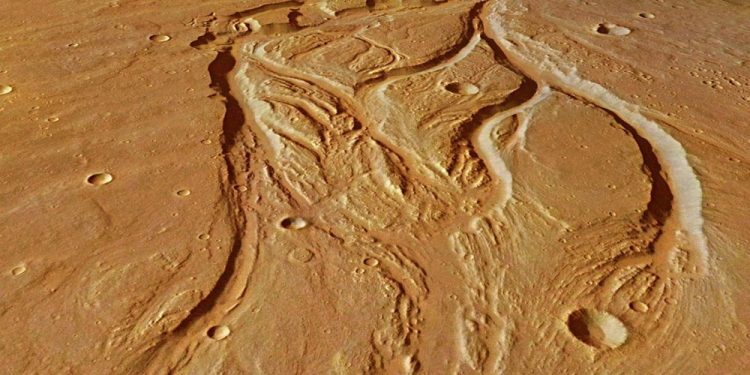Mars valleys traced back to precipitation

The central portion of Osuga Valles, which has a total length of 164 km. In some places, it is 20 km wide and plunges to a depth of 900 m. Photograph: ESA/DLR/FU Berlin, CC BY-SA 3.0 IGO
A new study now suggests that the branching structure of the former river networks on Mars has striking similarities with terrestrial arid landscapes. This has been demonstrated in a recent paper published in Science Advances by physicist Hansjörg Seybold from the group of James Kirchner, ETH professor at the Institute for Terrestrial Ecosystems, and planetary specialist Edwin Kite from the University of Chicago.
Valleys eroded mainly by rainwater
Using statistics from all mapped river valleys on Mars, the researchers conclude that the contours still visible today must have been created by superficial run-off of (rain)water. Consequently, the influence of groundwater seepage from the soil can be excluded as a dominant process for shaping these features.
The distribution of the branching angles of the valleys on Mars is very similar to those found in arid landscapes on Earth. According to lead author Seybold, this implies that there must have been a similar hydrological environment with sporadic heavy rainfall events on Mars over a prolonged period of time and that this rainwater may have run off quickly over the surface shaping the valley networks.
This is how river valleys develop in arid regions on Earth. For example, in Arizona, researchers observed the same valley network patterns in a landscape where astronauts are training for future Mars missions. Valleys in arid regions fork at a narrow angle.
The branching angles on Mars are comparatively low. Seybold therefore rules out the influence of groundwater sapping as the major channel forming process on Mars. River networks that are formed by re-emerging groundwater, as found, for example, in Florida, tend to have much wider branching angles between the two tributaries and do not match the narrow angles of streams in arid areas.
Conditions such as those found in terrestrial arid landscapes today probably prevailed on Mars for only a relatively short period about 3.6 to 3.8 billion years ago. In that period, the atmosphere on Mars may have been much denser than it is today. “Recent research shows that there must have been much more water on Mars than previously assumed,” says Seybold.
Evaporation made it rain
One hypothesis suggests that the northern third of Mars was covered by an ocean at that time. Water evaporated, condensed around the high volcanoes of the highlands to the south of the ocean and led to heavy precipitation. As a result, rivers formed, which left traces that can still be observed on Mars today.
The big question is where the water has disappeared to over time. “It's likely that most of it evaporated into space. But it could still be found in the vicinity of Mars,” says the physicist., ” but this is a question for a future space mission”.
###
Reference
Seybold HJ, Kite E, Kirchner JW. Branching geometry of valley networks on Mars and Earth and its implications for early Martian climate. Science Advances 2018; 4:eaar6692. DOI: 10.1126/sciadv.aar6692
Media Contact
All latest news from the category: Physics and Astronomy
This area deals with the fundamental laws and building blocks of nature and how they interact, the properties and the behavior of matter, and research into space and time and their structures.
innovations-report provides in-depth reports and articles on subjects such as astrophysics, laser technologies, nuclear, quantum, particle and solid-state physics, nanotechnologies, planetary research and findings (Mars, Venus) and developments related to the Hubble Telescope.
Newest articles

First-of-its-kind study uses remote sensing to monitor plastic debris in rivers and lakes
Remote sensing creates a cost-effective solution to monitoring plastic pollution. A first-of-its-kind study from researchers at the University of Minnesota Twin Cities shows how remote sensing can help monitor and…

Laser-based artificial neuron mimics nerve cell functions at lightning speed
With a processing speed a billion times faster than nature, chip-based laser neuron could help advance AI tasks such as pattern recognition and sequence prediction. Researchers have developed a laser-based…

Optimising the processing of plastic waste
Just one look in the yellow bin reveals a colourful jumble of different types of plastic. However, the purer and more uniform plastic waste is, the easier it is to…


